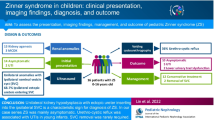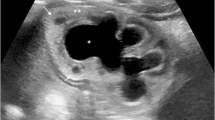Abstract
Background
Many genes and loci have been reported in genetic studies of primary vesicoureteral reflux (VUR), but few have been reproduced in independent cohorts, perhaps because of phenotype heterogeneity. We phenotyped children with VUR who attended urology clinics so we could establish criteria to stratify patients based on the presence or absence of a renal malformation.
Methods
History, chart review, and DNA were obtained for 200 children with VUR from 189 families to determine the grade of VUR, the mode of presentation, and the family history for each child. Kidney length measured on ultrasound (US) and technetium dimercaptosuccinic acid (DMSA) scans at the time of VUR diagnosis were used to establish the presence of a concurrent renal malformation and identify the presence of renal scarring.
Results
There was an even distribution of girls and boys, and most patients were diagnosed following a urinary tract infection (UTI). Thirty-four percent of the children had severe VUR, and 25 % had undergone surgical correction. VUR is highly heritable, with 15 % of the families reporting multiple affected members. Most patients had normally formed kidneys as determined by US and DMSA imaging. Of the 93 patients who underwent DMSA imaging, 17 (18 %) showed scarring, 2 (2 %) showed scarring and diffuse reduction in uptake, and 13 (14 %) showed an isolated diffuse reduction in uptake.
Conclusion
Prospective long-term studies of patients with primary VUR combined with renal phenotyping using US and DMSA imaging are needed to establish the presence of a renal malformation. The majority of patients in our study had no renal malformation. This cohort is a new resource for genetic studies of children with primary VUR.



Similar content being viewed by others
References
Williams G, Fletcher JT, Alexander SI, Craig JC (2008) Vesicoureteral reflux. J Am Soc Nephrol 19:847–862
Craig JC, Irwig LM, Knight JF, Roy LP (2000) Does treatment of vesicoureteral reflux in childhood prevent end-stage renal disease attributable to reflux nephropathy? Pediatrics 105:1236–1241
Studies NAPRTaC (2011) Annual Dialysis Report Annual Report
Information CIfH (2011) Canadian Organ Replacement Annual Report
Nagler EV, Williams G, Hodson EM, Craig JC (2011) Interventions for primary vesicoureteral reflux. Cochrane Database Syst Rev:CD001532
Kaefer M, Curran M, Treves S, Bauer S, Hendren W, Peters C, Atala A, Diamond D, Retik A (2000) Sibling vesicoureteral reflux in multiple gestation births. Pediatrics 105:800–804
Puri P, Gosemann JH, Darlow J, Barton DE (2011) Genetics of vesicoureteral reflux. Nat Rev Urol 8:539–552
Bertoli-Avella AM, Conte ML, Punzo F, de Graaf BM, Lama G, La Manna A, Polito C, Grassia C, Nobili B, Rambaldi PF, Oostra BA, Perrotta S (2008) ROBO2 gene variants are associated with familial vesicoureteral reflux. J Am Soc Nephrol 19:825–831
Lu W, van Eerde AM, Fan X, Quintero-Rivera F, Kulkarni S, Ferguson H, Kim HG, Fan Y, Xi Q, Li QG, Sanlaville D, Andrews W, Sundaresan V, Bi W, Yan J, Giltay JC, Wijmenga C, de Jong TP, Feather SA, Woolf AS, Rao Y, Lupski JR, Eccles MR, Quade BJ, Gusella JF, Morton CC, Maas RL (2007) Disruption of ROBO2 is associated with urinary tract anomalies and confers risk of vesicoureteral reflux. Am J Hum Genet 80:616–632
Ruf RG, Xu PX, Silvius D, Otto EA, Beekmann F, Muerb UT, Kumar S, Neuhaus TJ, Kemper MJ, Raymond RM Jr, Brophy PD, Berkman J, Gattas M, Hyland V, Ruf EM, Schwartz C, Chang EH, Smith RJ, Stratakis CA, Weil D, Petit C, Hildebrandt F (2004) SIX1 mutations cause branchio-oto-renal syndrome by disruption of EYA1-SIX1-DNA complexes. Proc Natl Acad Sci U S A 101:8090–8095
Sanyanusin P, Schimmenti L, McNoe L, Ward T, Pierpont M, Sullivan M, Dobyns W, Eccles M (1995) Mutation of the PAX2 gene in a family with optic nerve colobomas, renal anomalies and vesicoureteral reflux. Nat Genet 9:358–364
Yang Y, Houle AM, Letendre J, Richter A (2008) RET Gly691Ser mutation is associated with primary vesicoureteral reflux in the French-Canadian population from Quebec. Hum Mutat 29:695–702
Hiraoka M, Hori C, Tsukahara H, Kasuga K, Ishihara Y, Sudo M (1997) Congenitally small kidneys with reflux as a common cause of nephropathy in boys. Kidney Int 52:811–816
Olbing H, Hirche H, Koskimies O, Lax H, Seppanen U, Smellie JM, Tamminen-Mobius T, Wikstad I (2000) Renal growth in children with severe vesicoureteral reflux: 10-year prospective study of medical and surgical treatment: the International Reflux Study in Children (European branch). Radiology 216:731–737
Han BK, Babcock DS (1985) Sonographic measurements and appearance of normal kidneys in children. Am J Roentgenol 145:611–616
Sanna-Cherchi S, Caridi G, Weng PL, Dagnino M, Seri M, Konka A, Somenzi D, Carrea A, Izzi C, Casu D, Allegri L, Schmidt-Ott KM, Barasch J, Scolari F, Ravazzolo R, Ghiggeri GM, Gharavi AG (2007) Localization of a gene for nonsyndromic renal hypodysplasia to chromosome 1p32-33. Am J Hum Genet 80:539–549
Ylinen E, Ala-Houhala M, Wikstrom S (2003) Risk of renal scarring in vesicoureteral reflux detected either antenatally or during the neonatal period. Urology 61:1238–1242, discussion 1242–1233
Schwartz GJ, Gauthier B (1985) A simple estimate of glomerular filtration rate in adolescent boys. J Pediatr 106:522–526
Risch N (1990) Linkage strategies for genetically complex traits. II. The power of affected relative pairs. Am J Hum Genet 46:229–241
Wan J, Greenfield SP, Ng M, Zerin M, Ritchey ML, Bloom D (1996) Sibling reflux: a dual center retrospective study. J Urol 156:677–679
Chand DH, Rhoades T, Poe SA, Kraus S, Strife CF (2003) Incidence and severity of vesicoureteral reflux in children related to age, gender, race and diagnosis. J Urol 170:1548–1550
Mattoo TK (2011) Vesicoureteral reflux and reflux nephropathy. Adv Chron Kidney Dis 18:348–354
Feather S, Malcolm S, Woolf A, Wright V, Blaydon D, Reid C, Flinter F, Proesmans W, Devriendt K, Carter J, Warwicker P, Goodship TH, Goodship J (2000) Primary, nonsyndromic vesicoureteral reflux and its nephropathy is genetically heterogeneous, with a locus on chromosome 1. Am J Hum Genet 66:1420–1425
Cordell HJ, Darlay R, Charoen P, Stewart A, Gullett AM, Lambert HJ, Malcolm S, Feather SA, Goodship TH, Woolf AS, Kenda RB, Goodship JA (2010) Whole-genome linkage and association scan in primary, nonsyndromic vesicoureteral reflux. J Am Soc Nephrol 21:113–123
Kelly H, Molony CM, Darlow JM, Pirker ME, Yoneda A, Green AJ, Puri P, Barton DE (2007) A genome-wide scan for genes involved in primary vesicoureteral reflux. J Med Genet 44:710–717
van Eerde AM, Koeleman BP, van de Kamp JM, de Jong TP, Wijmenga C, Giltay JC (2007) Linkage study of 14 candidate genes and loci in four large Dutch families with vesicoureteral reflux. Pediatr Nephrol 22:1129–1133
Weng PL, Sanna-Cherchi S, Hensle T, Shapiro E, Werzberger A, Caridi G, Izzi C, Konka A, Reese AC, Cheng R, Werzberger S, Schlussel RN, Burk RD, Lee JH, Ravazzolo R, Scolari F, Ghiggeri GM, Glassberg K, Gharavi AG (2009) A recessive gene for primary vesicoureteral reflux maps to chromosome 12p11-q13. J Am Soc Nephrol 20:1633–1640
Briggs CE, Guo CY, Schoettler C, Rosoklija I, Silva A, Bauer SB, Retik AB, Kunkel L, Nguyen HT (2010) A genome scan in affected sib-pairs with familial vesicoureteral reflux identifies a locus on chromosome 5. Eur J Hum Genet 18:245–250
Conte ML, Bertoli-Avella AM, de Graaf BM, Punzo F, Lama G, La Manna A, Grassia C, Rambaldi PF, Oostra BA, Perrotta S (2008) A genome search for primary vesicoureteral reflux shows further evidence for genetic heterogeneity. Pediatr Nephrol 23:587–595
Chang HS, Kim KS, Chung IS (2009) Congenital small kidney can be an indicator of surgical treatment in children with primary vesicoureteral reflux. Urology 74:588–591
Upadhyay J, Bolduc S, Bagli DJ, McLorie GA, Khoury AE, Farhat W (2003) Use of the dysfunctional voiding symptom score to predict resolution of vesicoureteral reflux in children with voiding dysfunction. J Urol 169:1842–1846, discussion 1846; author reply 1846
Acknowledgments
We thank Marie-Lyne Fillion for critical reading of the paper and discussion, Lily Chin-Peuckert, Marika Edvi, and Julie Marrone Leduc for their assistance in patient recruitment, and Vicky Pascuzzo for her assistance in chart retrieval. This work was supported by an operating grant from the Canadian Institutes of Health Research (IRG). IRG holds a salary award from the Fonds de la Recherche en Santé du Québec.
Author information
Authors and Affiliations
Corresponding author
Rights and permissions
About this article
Cite this article
El Andalousi, J., Murawski, I.J., Capolicchio, JP. et al. A single-center cohort of Canadian children with VUR reveals renal phenotypes important for genetic studies. Pediatr Nephrol 28, 1813–1819 (2013). https://doi.org/10.1007/s00467-013-2440-9
Received:
Revised:
Accepted:
Published:
Issue Date:
DOI: https://doi.org/10.1007/s00467-013-2440-9




